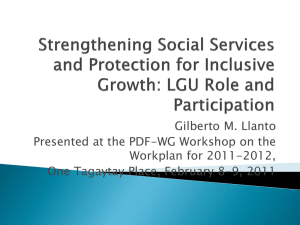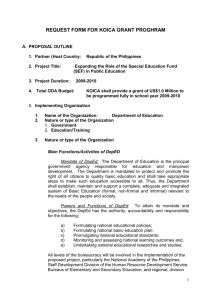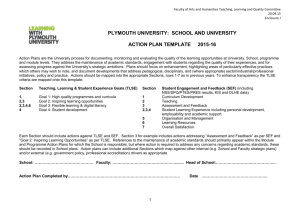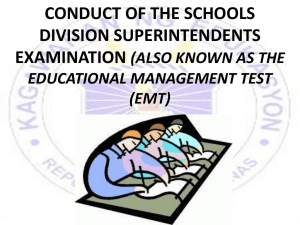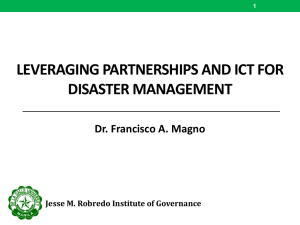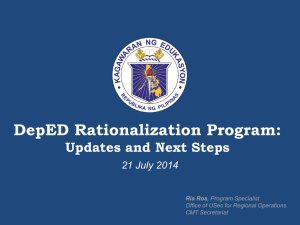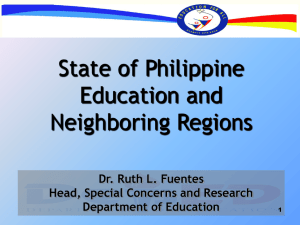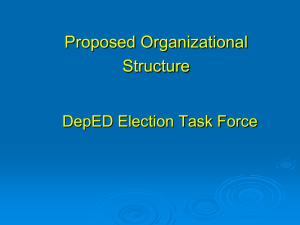- Department of Education
advertisement
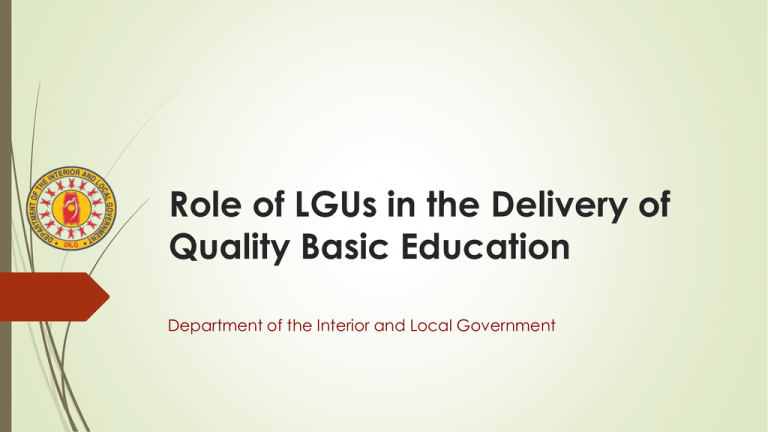
Role of LGUs in the Delivery of Quality Basic Education Department of the Interior and Local Government Outline of Presentation Role of LGUs on Basic Education Special Education Fund Legal Basis for Utilization Current Practice on Allocation of SEF Local Special Bodies Functions and Composition Challenges and Recommendations Reform SEF and LSBs to support education Increase SEF collection via updating SMV Context: why good education matters Educational attainment of HH head and poverty incidence, 2006 Poverty incidence No education Some elementary Elementary graduate Some high school High school graduate Some college College graduate ALL HHs 53.9 43.3 35.3 29.5 17.2 8.1 1.6 26.9 Contribution to total # of poor HHs 5.7 36.3 25.4 13.9 14.4 3.7 0.6 100.0 • Educational attainment of household head is important determinant of poverty status of HH. • Poverty incidence is found to be higher among households with household head with lower educational attainment. Role of LGUs in Basic Education Basic public education – still largely responsibility of central government, delivered through DepEd With devolution policy, providing for basic education is shared with LGUs. Basic services and facilities assigned to LGUs include school buildings and other facilities for public elementary and secondary schools (LGC, Sec. 17) LGUs provide supplementary finance for public basic education thru SEF which are the proceeds of 1% additional tax on real property (LGC, Sec. 235) LGUs have the means to contribute to the improvement of basic education outcomes through more efficient and effective use of the Special Education Fund (SEF). Special Education Fund (SEF) Special Education Fund (SEF) OVERVIEW/LEGAL FRAMEWORK (LGC Section 235 and Sec 272) SEF are proceeds from the additional one (1%) on the assessed value of real property tax which shall be in addition to the basic real property tax impost by provinces or cities, or a municipality within Metropolitan Manila Area (MMA). SEF shall be automatically released to the local school boards: Provided, that, in case of provinces, the proceeds shall be divided equally between the provincial and municipal school board. SEF income has been growing through the years, with increasing RPT assessments and a more aggressive tax collection by LGU. Utilization of SEF LGC (LGC Secs 100 and 272) prioritized SEF for (1) construction, repair & maintenance of school buildings and facilities; (2) extension classes; (3) educational research; (4) books and periodicals; and (5) sports development activities from barangay to national levels. Joint circulars of DepEd, DBM and DILG expanded list to include salaries of teachers and non-teaching personnel; IT resources; citizen development and other co-curricular activities. SEF: reliable source of funding for basic education Table 7. SEF Income and Expenditures, 2001-2007 (in million pesos) 2001 2002 2003 2004 2005 2006 2007 SEF Income Province Cities Municipalities 8,451 1,440 5,516 1,495 9,537 1,658 5,875 2,005 11,002 1,707 7,104 2,191 10,693 1,702 6,824 2,167 12,352 2,038 7,887 2,427 13,167 2,100 8,691 2,376 14,153 2,287 9,620 2,246 SEF Expenditures Province Cities Municipalities 7,774 1,456 4,953 1,365 7,395 1,377 4,411 1,607 8,826 1,510 5,397 1,920 8,854 1,554 5,384 1,916 10,265 2,010 6,155 2,100 12,249 1,646 8,424 2,179 12,063 1,669 8,511 1,883 11,022 1,990 7,016 2,016 7,838 1,515 4,744 1,580 10,068 2,062 5,807 2,198 10,311 1,956 6,219 2,136 11,067 2,047 6,679 2,340 13,226 2,180 8,722 2,324 13,816 2,175 9,182 2,459 100,393 105,923 108,074 107,941 109,182 122,718 145,860 Total LGU Educ Expd Province Cities Municipalities DepEd Expd incl. SBP SEF expd as % of Gen Gov educ expd 7.0 6.5 7.5 7.5 8.5 9.0 7.6 SEF expd as % of total DepEd expd 7.7 7.0 8.2 8.2 9.4 10.0 8.3 SEF expd as % of DepEd non-PS expd 61.0 86.4 83.9 73.9 85.5 80.6 41.0 SEF expd as % of DepEd MOOE 85.7 135.0 142.3 120.1 121.7 139.7 70.7 Source: Study of Manasan and Castel, 2010) SEF income grew from PhP 8.5 B in 2001 to PhP 14.2 B in 2007 SEF expenditure increased from PhP 7.8 B in 2001 to PhP 12.1 B in 2007 Equal to 7%-10% of total DepEd spending Equal to 6%-9% of total General Spending on Education Total LGU Expenditure on Education is P11B in 2011 to P 14B in 2007 Wide disparity in SEF resources across LGUs of different income classes Just as wide disparities in local income, there are substantial disparities in per pupil SEF spending across different income classes. To wit , per student spending of NCR cities is almost 3 times as 5th income class cities. This occurs primarily because the more urbanized LGUs tend to have larger RPT base as a result of the higher property values in these LGUs compared to less urbanized LGUs. Median SEF spending per pupil in municipalities and cities CY 2006 Municipal Income Class Median SEF of Cties City Income Class Median SEF 1st 143 NCR cities 1938 2nd 87 1st (non-NCR) 669 3rd 68 2nd-3rd 453 4th 59 4th 371 5th 45 5th 249 Source: Study of Manasan and Castel, 2010) SEF Expenditure In the aggregate, SEF expenditures per student in 2007 is significantly higher that the DedEp allocation for school level MOOE. In particular, if one assumes that all SEF are expenditures are spent on school level MOOE and if SEF are distributed across LGUs in direct proportion to enrollment, their per student ratio would be P 692 which is 3.4 x the DepEd allocation for school level MOOE. SEF Expenditure per student vs. DepEd School-level MOOE per student SY 2007-2008 DepEd School Level MOOE per Student Aggregate SEF expenditure per Student Elementary level Secondary level regular curriculum tech-voc-curriculum Aggregate SEF expenditure per student P 692 - P 207 - P 500 - P 700 Source: Study of Manasan and Castel, 2010) Current Practice on Allocation of SEF In the aggregate, • almost half of the SEF is spent on MOOE • 27-29% for PS and • 23-30% to CO. Budget Share of PS, MOOE, and CO in SEF expenditures, CY 2006-2008 CY Year PS MOOE CO 2006 26.6 43.3 29.6 2007 29.1 48.4 22.5 2008 28.7 48.8 22.5 Source: Study of Manasan and Castel, 2010) 2010 study on how to improve the SEF (Manasan, Castel) FINDINGS 1. Excessive emphasis on hiring locally funded teachers vis-à-vis low priority for school building construction 2. Unclear interpretation of LGC as to the “operation and maintenance of schools” 3. Mismatch between actual school-level needs and LGU spending priorities for SEF 4. Need to clarify “sports activities” in light of transfer of DEpEd functions related to sports competition to the Philippine Sports Commission under RA 9155 Local School Boards (LSBs) Local School Boards (one of the Local Special Bodies) Local Special Bodies Councils, committees or the like created to perform definite functions on the LGUs. There are five of such bodies, namely, Local Development Councils (LDC) Local Prequalification, bids, and awards committees (LPBAC) Local School Boards (LSB) Local Health Boards (LHB) Local Peace and Order Council (LPOC) There shall be established in every province, city, or municipality a provincial, city, or municipal school board The LSB is the body primarily responsible for the allocating the share of the LGU in the Special Education Fund (SEF). Functions of the Local Special Bodies Local Development Council • Assist the Sanggunian in setting the direction of economic and social development and coordinate development efforts Local Health Boards • Advisory to the Sanggunian on health matters • Propose budgetary allocation for health facilities and services Local School Boards • Advisory to the Sanggunian on education matters • Responsible for allocating the share of LGUs in the SEF Local Peace and Order Council Local Prequalification, Bids and Awards Committee • Responsible for proposing programs for peace, order and public safety in localities • Responsible for prequalification of contractors, bidding, evaluation of bods and recommendation of awards of projects Activities and Budget of LSBs (LGC Sec. 100) Meet at least once a month or as often as may be necessary. Local chief executive concerned, as a matter of protocol, shall be given preference to preside the over the meeting. Division superintendent, city superintendent or district supervisor, as the case may be, shall prepare the budget of the school board concerned. Such budget shall be supported by programs, projects, and activities of the school board for the ensuing fiscal year. The affirmative vote of the majority of all the members shall be necessary to approve the budget. Challenges and Recommendations Challenges Need for greater alignment of the SEF with the programs and priorities of national government. Information on the allocation from the national budget have to be communicated to LGUs to ensure the SEF is used to advance programs for basic education. Need for clearer statements as to allowable expenditures chargeable to SEF expenditures under SEF particularly expenditures are included under “expenditures for operation and maintenance of public schools” as per Sec. 272 of LGC Need for clearer assignment of expenditure responsibility – DepEd vs. provincial LSB vs. municipal/ city LSB Need to strengthen link between LSB/ SEF utilization and implementation of Kto12 Information sharing between DepEd (not just at Division and District Office level but also Central Office level) and LSBs Need for better coordination between provincial LSBs and municipal LSBs How does LSB relate to School Governance Council? Proposed Recommendations Improve SEF utilization guidelines prescribed in LGC Avoid expenditure overlaps by clarifying well who should spend for what--DepEd or LGUs e.g. textbooks Increase equity in education spending by providing more to LGUs with low real property tax base Proposed Recommendations Improve revenue collection for SEF. SEF grows when RPT collections improve • The efficiency of LGUs in collecting real property taxes improved significantly between 2007 and 2012. RPT collection efficiency (collections as a proportion of collectible amount), 2006-2012 Provinces (w/ munis) Cities All LGUs 2006 68.6 89.9 82.2 2007 52.8 95.1 73.1 2008 58.9 78.3 71.5 2009 68.9 70.5 70.2 2010 64.8 82.4 76.4 2011 74.3 79.2 77.6 2012 77.9 85.9 83.3 Challenges PROBLEM: real property values are not being updated Age of real property values over 10 years 6 - 10 years 5 years or less TOTAL Provinces Cities Number % Number % 19 23.8 58 40.3 28 35.0 46 31.9 33 41.3 40 27.8 80 100.0 144 100.0 Outdated Valuation Political Difficulty Many LGUs have NOT regularly updated their schedule of market values—the basis for computing the RPT—resulting in lowerthan-expected collections. Sanggunian members, who must approve the new market values, are reluctant to enact the relevant ordinance due to its political backlash. Proposed Recommendations Transfer the mandate to approve the schedule of market values (SMV) for real property from the Sanggunian to the Department of Finance LGUs to retain autonomy in setting assessment levels and tax rates for real property Thank you
